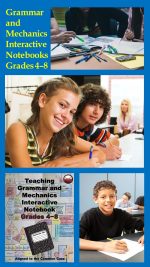Grammar Programs
Teachers frequently ask which Pennington Publishing grammar program will best meet the needs of their students. Of course most of us use grammar as a catch all term to mean parts of speech, syntax, usage, sentence structure, subjects and predicates, punctuation, quotation marks, and capitalization. For those teachers using the Common Core Standards, they are looking for materials to teach the Language Strand 1, 2, and 3 Standards.
How to Choose the Right Grammar Program
Instructional style and time are the chief criteria in choosing the program which will work best for you and your students. Read the following “quick look” descriptions and make sure to click on any that interest you to see the expanded product description and plenty of program samples on our site. However, before you navigate away from this page, copy down our discount code 3716 to take 10% off of the price of any Pennington Publishing products at check-out.
Traditional and Comprehensive Full-Year Programs
Pennington Publishing provides six grade-level Teaching Grammar and Mechanics programs (grades 4, 5, 6, 7, 8, and high school) to teach each of the CCSS grade-level Standards and Progressive Skills Review (alignment documents included). Absolutely no prep is needed and all answers are provided. YouTube training videos ensure teaching success.
Each of the grade-level programs provides 56 interactive language conventions lessons, designed for twice-per-week direct instruction. The scripted lessons (perfect for the grammatically-challenged teacher) are formatted for classroom projection. Standards review, definitions and examples, practice and error analysis, simple sentence diagrams, mentor texts with writing applications, and formative assessments are woven into every 25-minute lesson.
Students annotate the full text of the lesson on accompanying student worksheets (included in the program). The worksheets include a practice section, a simple sentence diagram, a mentor text which applies the grammatical lesson focus, and a brief writing application. Students complete two sentence dictation formative assessments and then self-correct from the projected display.
Biweekly grammar, usage, and mechanics unit tests require students to define, identify, and apply their knowledge of these Language Standards in the writing context.
Individualized Assessment-based Instruction: Teaching Grammar and Mechanics also includes all resources for teachers to meet the diverse instructional needs of individual students. Perfect for English-language learners, special education, and remedial students! The program provides diagnostic grammar and mechanics assessments to determine the specific remedial needs of your students.
Teachers individualize instruction according to the results of the diagnostic assessments with targeted grammar, usage, and mechanics worksheets. Each worksheet includes definitions, examples, writing hints, and a practice section. Students self-correct each worksheet to learn from their mistakes and then and complete a short formative assessment. The teacher corrects the formative assessment to determine mastery. Students catch up while they keep up with grade-level instruction.
“Teaching Grammar and Mechanics is the most comprehensive and easy to teach grammar and mechanics program I’ve ever taught. It’s got everything! I’m teaching each grade-level Standard and students are filling in the gaps from previous grade level Standards. This program is written by teachers for teachers and their students. You can tell. Takes no prep and hardly any correction. Both veteran teachers like me and new ELA teachers will really appreciate the scripted grammar lessons.”
Robin M.
Grammar Interactive Notebook
The Teaching Grammar and Mechanics Interactive Notebook Grades 4-8 program will help your students master each of the Common Core grade-level grammar and mechanics Standards. This rigorous, fun, and easy-to-teach interactive notebook is neither a fact-filled collection of boring lecture notes, nor a time-wasting portfolio of art projects.
- Grades 4- 8 lessons aligned to the Common Core (alignment documents included). Note that this is not specifically a grade-level program.
- 64 Lessons designed in the interactive Cornell Notes format with plenty of online links to help students practice. Lessons take 40 minutes, twice per week.
- Students are provided the full note-taking text and write only the examples from the teacher display. LESS time copying and MORE time learning. Students self-correct from answers on the display. Plenty of practice in this program.
- Brief grammar and mechanics sentence dictations to formatively assess whether students have achieved mastery.
- Students read, laugh, and respond to 64 color grammar cartoons by master cartoonist, David Rickert.
- Students use their grammar and mechanics notes to label, color, cut, and glue 3d graphic organizers from easy step-by-step directions. Completed color graphics (the answers) are included to serve as models. No need to create a teacher INB; it’s done for you and for absent student make-up work.
- Minimal preparation and correction. Just copy off two or three student pages and set out the materials. Students self-correct throughout every INB lesson and with the remedial worksheets to learn from their mistakes and save you time.
- Biweekly unit tests with answers assess definition, identification, and application of the grammar and mechanics concepts and skills.
- Diagnostic assessments with over 100 targeted remedial worksheets and online resources. Students complete the worksheet practice, self-correct and edit from the answer booklets, take a brief formative assessment, and mini-conference with you to assess whether students have mastered the Standard.
This interactive notebook is a great resource! My students enjoy learning grammar in a different way.
Shannon M.
Oh my gosh-cannot believe this! Not only does this include graphic organizers, but resource materials and guided instructions. This is amazingly cool!

Syntax in Reading and Writing
Michelle G.
Get the Grammar and Mechanics Grades 4-8 Instructional Scope and Sequence FREE Resource:
![]()
Get the Diagnostic Grammar and Usage Assessment FREE Resource:
![]()
Get the Diagnostic Mechanics Assessment FREE Resource:
![]()
Grammar/Mechanics, Literacy Centers, Spelling/Vocabulary, Study Skills, Writing








